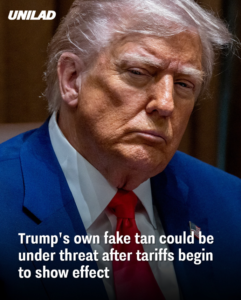Trump’s Own Fake Tan Could Be Under Threat as Tariffs Begin to Show Effect
In a twist that blurs the line between politics and personal style, Donald Trump’s signature orange-hued tan might soon be the unexpected victim of his own trade policies. As tariffs on imported goods continue to take hold, products in the beauty and skincare industry—specifically those containing ingredients or formulations made abroad—are facing price hikes and potential shortages. Among these, sunless tanning products are beginning to feel the heat.
While Trump’s famously bronzed complexion has often been the subject of late-night jokes and memes, sources close to the beauty industry suggest that the type of tanning products that create that unmistakable glow are becoming more expensive and harder to source. DHA (dihydroxyacetone), the active ingredient in most self-tanners, is frequently manufactured overseas, particularly in countries now subject to new or increased tariffs.
Many luxury self-tanners, including spray tan formulas favored by celebrities and public figures, rely on complex international supply chains. These products are not only expensive to begin with, but now face significant import taxes. This has led to delays, diminished stock, and inflated prices—consequences that may be trickling up even to the highest-profile users.
“It’s ironic,” said one anonymous beauty supplier. “The very tariffs championed by the former president may end up impacting the cost of his own glow.”
While there is no official word on Trump’s exact tanning routine—whether it involves high-end sprays, lotions, or even a dedicated technician—industry insiders speculate he has preferred top-shelf, salon-grade products not readily found on the shelves of your average pharmacy. And many of these elite products are European imports, which have recently come under tariff scrutiny due to broader trade conflicts.
This development is more than cosmetic—it highlights the broader ripple effects of aggressive trade policies. Consumers are already seeing rising costs in categories ranging from electronics to clothing, and now the beauty industry is feeling the squeeze. Salons across the country report higher costs for tanning solutions, with some passing those costs onto customers. For individuals with daily or weekly tanning regimens, that can mean a noticeable increase in their beauty budget.
Critics of Trump’s trade approach have pounced on the irony. Social media is ablaze with quips suggesting the former president may have to “go natural” or “embrace the pale” if his favored products become too costly or scarce. Political opponents have also used the moment to underscore what they view as the self-defeating nature of protectionist policies—hurting even those who champion them.
Of course, whether Trump will change his tanning habits remains to be seen. But the incident underscores a broader truth: no one, not even a billionaire former president, is immune from the consequences of global economic shifts. And in this case, the glow that became a symbol of Trump’s brand might start to fade—not by choice, but by tariff.
